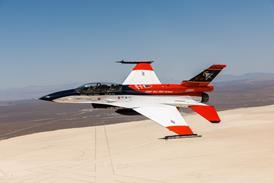Guy Norris/LOS ANGELES
NORTHROP GRUMMAN is testing a pressurised wing concept using rapid prototyping methods at its B-2 plant in Pico Rivera, California (Flight International, 28 February - 5 March).
The "distributed exhaust" or high-tolerance "blowing-wing" design, forces pressurised air bled from the engine through 0.7622mm-diameter holes in the upper surface of the wing.
The flow would re-energise the boundary layer, increasing lift at lower speeds and reducing drag at higher speeds. The system effectively combines the benefits of laminar flow control by suction, which was tried successfully by Northrop and NASA with the X-21A, with circulation-control methods demonstrated with the UK-built Blackburn Buccaneer.
Northrop Grumman, B-2 division test and design organisation lead engineer, Ed Hobart says, "We're still in the testing phase, and the next step will be to test a full-scale section." Wind tunnel tests have been conducted with smoke and tufts, "...but we haven't tried Doppler-laser yet", he adds. For the tests, the wing was pressurised to between 0.345 and 1.38bar (5 and 20ib/in2) inside a low-speed wind tunnel.
The entire programme has been made feasible by the use of stereolithography (SL), a technology developed by California-based 3D Systems. This allows three-dimensional plastic objects to be made directly from computer-aided design data. "This technology has proven itself to us, not only on this but on other projects," says Hobart.
Manufacturing eight different test configurations of the upper-surface blowing section of the wing took 1,204h using SL methods compared to an estimated 4,300h using conventional techniques.
"That's even if we had been able to make them at all. It is a very cost-effective way of rapid prototyping," adds Hobart.
Because of the large size of the wing section, separate SL models were produced using AlliedSignal's Exactomer 2201 resin. These were then bonded together to form a complete wing section. Later models were made from the slightly tougher Cibatool SL 5170 epoxy resin. The SL models were then available to be used as mouldings for later test articles.
Northrop Grumman says that since January 1995 the SLA250 rapid prototyping machine has been in operation 24h a day. A more advanced version is on order for later in 1996.
Source: Flight International
















